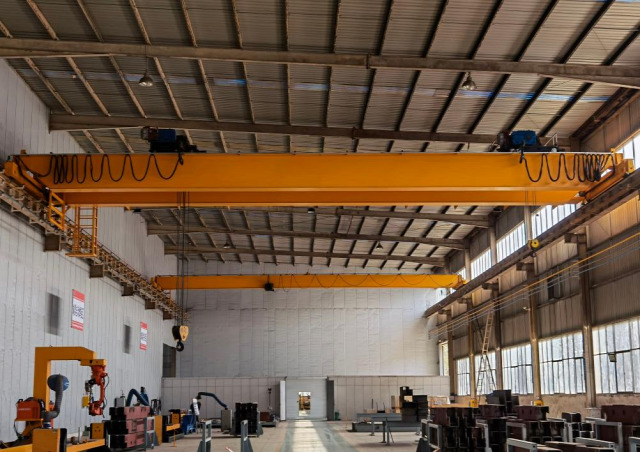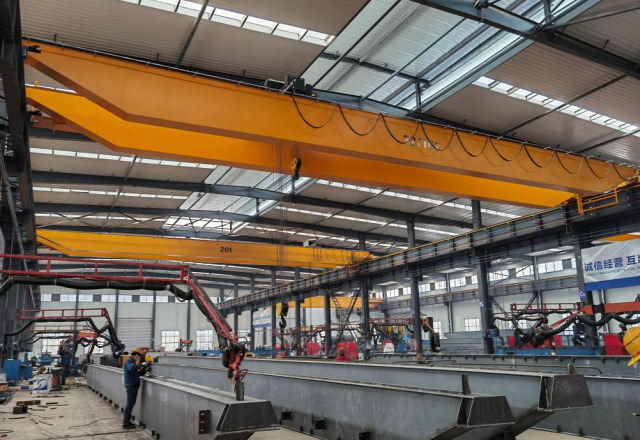When it comes to selecting the right double girder overhead crane manufacturer, businesses are faced with a crucial decision. The reliability, performance, and longevity of your crane are all tied to the manufacturer’s expertise, quality standards, and customer service. A double girder overhead crane is a significant investment that plays a vital role in material handling, lifting, and moving heavy loads in industries such as manufacturing, construction, steel production, and shipbuilding. Choosing the right manufacturer is essential for ensuring that your crane meets your specific operational needs and delivers long-term value.
In this article, we will explore key considerations and steps for choosing the right double girder overhead crane manufacturer, covering everything from technical expertise to after-sales service.

1. Assess Your Operational Requirements
Before diving into the search for a manufacturer, it’s essential to have a clear understanding of your operational requirements. Double girder overhead cranes come in various configurations, load capacities, and span lengths, so the first step is to identify the specific needs of your business.
- Load capacity: What is the maximum weight the crane will need to lift? Double girder cranes typically handle heavier loads, so ensure that the manufacturer can provide cranes with the appropriate capacity, whether it’s 20 tons, 50 tons, or more.
- Lifting height: How high will the crane need to lift materials? This is particularly important for industries like shipbuilding or construction, where lifting height may be substantial.
- Span length: Consider the width of the area the crane needs to cover. The span should match your facility’s layout to ensure the crane operates efficiently.
- Work environment: Will the crane be used indoors or outdoors? Harsh environments such as steel mills or shipyards may require specific corrosion-resistant materials or protective coatings.
- Work duty: Is your operation light, medium, or heavy-duty? Different cranes are designed to handle various work intensities, so ensure the crane’s duty cycle aligns with your application.

2. Research the Manufacturer’s Expertise and Experience
Once you have outlined your requirements, it’s time to evaluate potential manufacturers. The expertise and experience of the manufacturer are crucial indicators of their ability to provide reliable and high-quality overhead cranes.
- Years in the industry: Look for manufacturers with a strong track record and several years, if not decades, of experience in designing and producing double girder overhead cranes. Established manufacturers often have a deeper understanding of various industrial needs and technical challenges.
- Specialization: Ensure that the manufacturer specializes in overhead cranes, particularly double girder designs. Some companies may offer a broad range of lifting equipment but lack in-depth expertise in the specific crane type you need.
- Portfolio of projects: Examine the manufacturer’s portfolio to see if they have successfully completed projects similar to yours. This can give you confidence that they understand the complexities of your industry, whether it’s manufacturing, steel production, or logistics.
- Technological innovation: Choose a manufacturer that invests in research and development (R&D) to continuously improve their crane designs. Innovations such as anti-sway systems, remote control options, and energy-efficient motors can significantly enhance the performance and safety of your double girder overhead crane.
3. Quality Assurance and Compliance with Standards
The quality of the crane is a direct reflection of the manufacturer’s production standards. It’s essential to choose a manufacturer that prioritizes quality assurance and adheres to relevant industry standards.
- Material quality: High-quality materials such as steel are critical for the durability and safety of your crane. Ensure that the manufacturer uses premium-grade materials in the construction of crane components, including the girder, hoist, trolley, and end trucks.
- Manufacturing standards: Look for manufacturers that comply with international quality standards, such as ISO 9001. Compliance with these standards indicates that the company follows strict quality management processes.
- Testing and inspection: A reputable manufacturer will conduct thorough testing and inspection of their cranes before delivery. This includes load testing, operational testing, and ensuring that all components function optimally under various conditions.
- Certifications: Verify if the manufacturer’s cranes are certified by recognized industry bodies, such as the American Society of Mechanical Engineers (ASME) or European Federation of Material Handling (FEM). Certification ensures that the crane meets stringent safety and performance requirements.
4. Customization Capabilities
Every business has unique needs, and a one-size-fits-all approach may not be the best solution. Choose a manufacturer that offers customization options to tailor the crane to your specific requirements.
- Design flexibility: Can the manufacturer design the crane to fit your facility’s layout, lifting requirements, and environmental conditions? Customizations such as specialized hoists, trolley systems, or control modes can enhance the crane’s usability.
- Additional features: Consider whether the manufacturer offers advanced features such as variable frequency drives (VFD) for smooth motion control, automatic positioning systems, or integration with existing automation systems in your facility.
- Modular designs: Some manufacturers offer modular crane designs that allow for future expansion or upgrades. This flexibility can be valuable as your business grows or your operational needs change.
5. After-Sales Service and Support
A double girder overhead crane requires ongoing maintenance and occasional repairs to ensure smooth operation. The manufacturer’s after-sales service plays a critical role in minimizing downtime and keeping the crane in optimal condition.
- Warranty: Check the manufacturer’s warranty policy. A comprehensive warranty indicates the manufacturer’s confidence in the quality and durability of their cranes.
- Maintenance services: Does the manufacturer offer routine maintenance services or maintenance contracts? Regular inspections and maintenance are essential for preventing unexpected breakdowns and extending the crane’s lifespan.
- Spare parts availability: Ensure that the manufacturer has a reliable supply of spare parts for quick repairs. Downtime can be costly, so having access to essential parts such as motors, hoists, and brakes is crucial.
- Technical support: Choose a manufacturer that provides ongoing technical support, both remotely and on-site, if necessary. Whether it’s troubleshooting an issue or training your operators, responsive support is invaluable for minimizing operational disruptions.
6. Customer Reviews and Reputation
Lastly, it’s important to consider the manufacturer’s reputation in the market. Customer reviews and testimonials can provide insight into the manufacturer’s reliability, product quality, and customer service.
- Client feedback: Look for customer reviews on third-party platforms or request case studies from the manufacturer. Positive feedback from satisfied clients can be a strong indicator of the manufacturer’s ability to deliver on their promises.
- Industry recognition: Check if the manufacturer has received any industry awards or recognition for their crane designs or customer service. This can further validate their standing in the market.
Conclusion
Choosing the right double girder overhead crane manufacturer is a critical decision that requires careful consideration of several factors. By assessing your operational requirements, evaluating the manufacturer’s expertise, ensuring quality standards, and reviewing after-sales support, you can select a manufacturer that provides a reliable, durable, and efficient crane solution tailored to your business needs. Taking the time to choose the right partner will not only optimize your material handling operations but also ensure long-term success and safety in your industrial processes.

